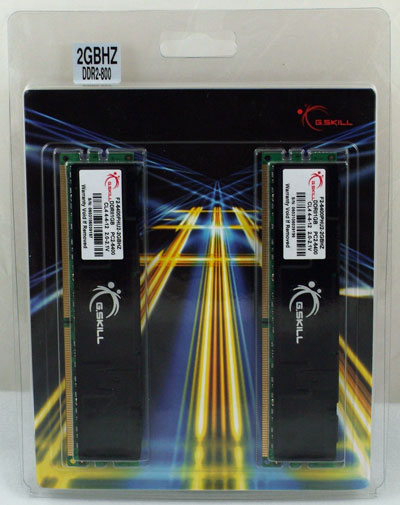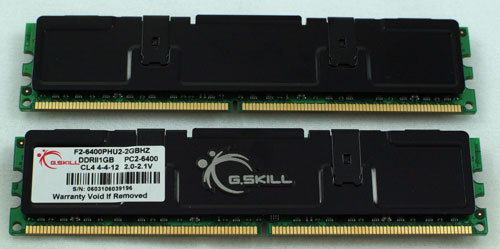Mid-Range DDR2-800 from G.Skill
Many readers have been looking for DDR2-800 as memory prices sky-rocketed over the last couple of months. Now that memory prices are dropping, there is less pressure to save money with DDR2-800 instead of top-line DDR2-1000 or DDR2-1066. However, the question still remains whether a step down to DDR2-800 will save a few bucks while delivering performance about as good as the top DDR2 memory.
Almost every major memory manufacturer has DDR2-800 parts, but the ones of greatest interest to hobbyists are those from well-known high-end memory makers. G.Skill seemed to come out of nowhere a couple of years ago to establish themselves as a manufacturer of enthusiast memory. They got exposure and won credibility with Forum targeting and a sharply focused advertising campaign. G.Skill distributes a full line of desktop and notebook memory products, and the line includes a 2GB DDR2-800 4-4-4 kit at a mid-level price in the $300 range.
G.Skill DDR2-800 Specifications
Since it has only recently appeared on the US and European scene, it was a little surprising to find that G.Skill has been producing memory products since 1989. Manufacturing is based in Taipei, Taiwan and G.Skill serves memory markets in most of the world. The G.Skill website provides English, German, Chinese, and Korean versions - typical of the Taiwanese websites that cater to world markets.
As you will see on the website G.Skill targets the computer enthusiast, with a strong emphasis on overclocking and extreme performance. The DDR2 product line includes kits rated from DDR2-533 to DDR2-1067. DDR2-800 kits include both 1GB (2x512MB) and 2GB (2x1GB) kits rated at 5-5-5-15, 4-4-4-12, and 3-4-3-8.
Competitive with other high-end memory makers, G.Skill provides a Lifetime Warranty with their memory products. The RMA form can be accessed at the web site. Technical support and a Users Forum are also available at the website.

To satisfy readers' requests for a mainstream DDR2-800 memory product we selected the DDR2-800 2GB kit rated at 4-4-4-12. You can also buy cheaper DDR2-800 G.Skill kits at e-tailers like www.newegg.com. A 2GB G.Skill 5-5-5-15 kit sells for $210 to $260, some $40 to $90 less than the faster 4-4-4-12.

The G.Skill F2-6400PHU2-2GBHZ 2GB kit is supplied with attractive gloss black heatspreaders with a G.Skill logo in brushed metal. Many G.Skill DIMMs do not even have heat-spreaders, and G.Skill seems to reserve the heatspreaders for their top memory.
G.Skill builds their DIMMs with Micron D9 memory chips - the same chips we have described as top performers in every recent high-end memory review. However, the binning for these chips is a bit different. G.Skill uses Micron D9GMH chips rated at 333, 3ns in this 4-4-4-12 DDR2-800 kit. Most top-end DIMMs use D9GKX chips which are binned for higher specs. Still, with Micron D9 chips, we expect excellent overclocking with these G.Skill DIMMs.
While top-end Micron memory chips have easily delivered 3-3-3 timings at DDR2-800, G.Skill rates this memory kit at slower 4-4-4 timings. The good news, however, is the more modest 2.0V-2.1V specification for memory voltage. This is much lower than the 2.2V-2.3V that is normally required for DDR2-800 at 3-3-3 timings. It also represents memory voltages that are normally available even on more basic Core 2 Duo and AM2 motherboards.
The memory chips are slower bins from the best chips available. Timings are a bit slower and voltage specs are more reasonable. The question remains whether the G.Skill DDR2-800 4-4-4-12 kits are a top-of-the-line memory in disguise, or whether there are compromises to top performance? Does the cost/performance of these DDR2-800 modules represent real value to buyers?
Many readers have been looking for DDR2-800 as memory prices sky-rocketed over the last couple of months. Now that memory prices are dropping, there is less pressure to save money with DDR2-800 instead of top-line DDR2-1000 or DDR2-1066. However, the question still remains whether a step down to DDR2-800 will save a few bucks while delivering performance about as good as the top DDR2 memory.
Almost every major memory manufacturer has DDR2-800 parts, but the ones of greatest interest to hobbyists are those from well-known high-end memory makers. G.Skill seemed to come out of nowhere a couple of years ago to establish themselves as a manufacturer of enthusiast memory. They got exposure and won credibility with Forum targeting and a sharply focused advertising campaign. G.Skill distributes a full line of desktop and notebook memory products, and the line includes a 2GB DDR2-800 4-4-4 kit at a mid-level price in the $300 range.
G.Skill DDR2-800 Specifications
Since it has only recently appeared on the US and European scene, it was a little surprising to find that G.Skill has been producing memory products since 1989. Manufacturing is based in Taipei, Taiwan and G.Skill serves memory markets in most of the world. The G.Skill website provides English, German, Chinese, and Korean versions - typical of the Taiwanese websites that cater to world markets.
As you will see on the website G.Skill targets the computer enthusiast, with a strong emphasis on overclocking and extreme performance. The DDR2 product line includes kits rated from DDR2-533 to DDR2-1067. DDR2-800 kits include both 1GB (2x512MB) and 2GB (2x1GB) kits rated at 5-5-5-15, 4-4-4-12, and 3-4-3-8.
Competitive with other high-end memory makers, G.Skill provides a Lifetime Warranty with their memory products. The RMA form can be accessed at the web site. Technical support and a Users Forum are also available at the website.

To satisfy readers' requests for a mainstream DDR2-800 memory product we selected the DDR2-800 2GB kit rated at 4-4-4-12. You can also buy cheaper DDR2-800 G.Skill kits at e-tailers like www.newegg.com. A 2GB G.Skill 5-5-5-15 kit sells for $210 to $260, some $40 to $90 less than the faster 4-4-4-12.

The G.Skill F2-6400PHU2-2GBHZ 2GB kit is supplied with attractive gloss black heatspreaders with a G.Skill logo in brushed metal. Many G.Skill DIMMs do not even have heat-spreaders, and G.Skill seems to reserve the heatspreaders for their top memory.
G.Skill builds their DIMMs with Micron D9 memory chips - the same chips we have described as top performers in every recent high-end memory review. However, the binning for these chips is a bit different. G.Skill uses Micron D9GMH chips rated at 333, 3ns in this 4-4-4-12 DDR2-800 kit. Most top-end DIMMs use D9GKX chips which are binned for higher specs. Still, with Micron D9 chips, we expect excellent overclocking with these G.Skill DIMMs.
| G.Skill F2-6400PHU2-2GBHZ Memory Specifications | |
| Number of DIMMs & Banks | 2 DS |
| DIMM Size | 1GB |
| Total Memory | 2 GB |
| Rated Timings | 4-4-4-12 at DDR2-800 |
| Rated Voltage | 2.0V to 2.1V |
While top-end Micron memory chips have easily delivered 3-3-3 timings at DDR2-800, G.Skill rates this memory kit at slower 4-4-4 timings. The good news, however, is the more modest 2.0V-2.1V specification for memory voltage. This is much lower than the 2.2V-2.3V that is normally required for DDR2-800 at 3-3-3 timings. It also represents memory voltages that are normally available even on more basic Core 2 Duo and AM2 motherboards.
The memory chips are slower bins from the best chips available. Timings are a bit slower and voltage specs are more reasonable. The question remains whether the G.Skill DDR2-800 4-4-4-12 kits are a top-of-the-line memory in disguise, or whether there are compromises to top performance? Does the cost/performance of these DDR2-800 modules represent real value to buyers?










30 Comments
View All Comments
Wesley Fink - Friday, November 3, 2006 - link
Yes, you can use dividers in overclocking. The ratios and underlying frequencies are more complicated than they appear on the surface, but we have shown in numerous memory reviews that the penalty for not running the preferred 1:1 is really pretty small.If cost is a constraint in a build then money put in a video upgrade first will deliver the most improvement in performance, a CPU would be the next place the upgrade yields great value. Higher memory speeds do increase performnace, but the increases are very small compared to a video card upgrade or a CPU upgrade.
Madellga - Saturday, November 4, 2006 - link
How do you run the memory slower?This was an option with the A64, but so far with the 965 chipset the options are to run the the memory faster, not slower.
My sample size is small, but both the Abit AW9D (975) and Gigabyte DS4 (965) don't have ratios to slow down the memory.
Wesley Fink - Saturday, November 4, 2006 - link
The memory may be RATED at DDR2-800, but you can select memory ratios to run the base at DDR2-400, 533, 667, 800, 1066 and sometimes in-between ratios. That allows you to set the memory at DDR2-400, for example, and overclock your CPU to much higher levels. This is how we test memory at different speeds. This feature is also available on almost every 975, 965, and AM2 board we have tested - except the very lowest models.For example, if I set my DDR2-800 to DDR2-533 (1:1 ratio) I can overclock my bus to 1600 (400 FSB) and then be at the specifed speed of DDR2-800. Remember the bus is quad-pumped on Intel - 266 is the base setting for 1067. Memory is DOUBLE dat tate, so DDR2-533 is a base setting of 266 - that is whay it is 1:1. So at a 400 setting bus speed is 1600 and memory is DDR2-800.
Madellga - Sunday, November 5, 2006 - link
Wes, thanks for the explanation. I've always used 1:1, when you mentioned using dividers I thought you meant something under 1:1.The A64 "dividers" were less confusing than Intel's memory straps, despite the fact how the divider was calculated.
vailr - Friday, November 3, 2006 - link
Any thought of running the memory tests under Windows XP x64? Do the Sandra benchmark tests run in the x64 operating system?Gary Key - Friday, November 3, 2006 - link
The Sandra benchmarks will run fine in XP-64. Once VISTA goes is RTM then we will be switching over to this OS. We had thought about doing some XP-64 tests when Conroe launched but decided to wait (and wait and wait and wait as it turns out) for VISTA.vailr - Friday, November 3, 2006 - link
Vista will also be offered in x64 and "x86" versions. Which version will be favored, as far as AT reviews & benchmark tests?Wesley Fink - Friday, November 3, 2006 - link
64-bit Vista is touted as the PRO version, with 32-bit Vista more akin to XP Home. Unless there are strong reasons otherwise the 64-bit version will likely be the standard.MxChris - Friday, November 3, 2006 - link
How is this different from this set: http://www.newegg.com/Product/Product.asp?Item=N82...">F2-6400CL4D-2GBPK that I bought a coule months ago? Looks to have exactly the same rated timings and specs according to newegg.Wesley Fink - Friday, November 3, 2006 - link
According to G. Skill specs, your memory is rated 1.9-2.0V at 4-4-4-12 and it is pictured with a pale blue heatspreader. Our test dimms are rated 2.0-2.1V for the same timings and have black heatspreaders. You will need to ask G. Skill if your dimms use different memory chips since we don't have samples available to check the chips used on your model number.Your G. Skill kit is curently selling for $240 at newegg compared to $299 for the kit we tested, so I suspect they are based on different memory chips. The Micron chips are notoriously expensive - even with slower bins -and we have seen Mosel used in some mid memory of late, as well as the Elpida that is normal for low-mid memory.